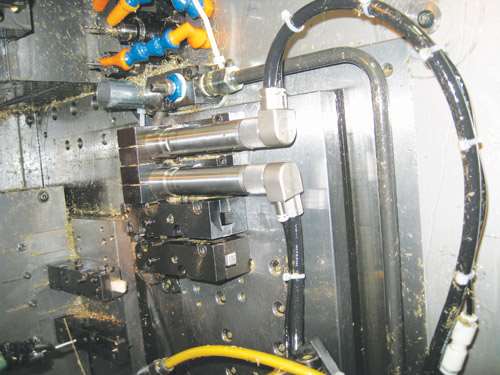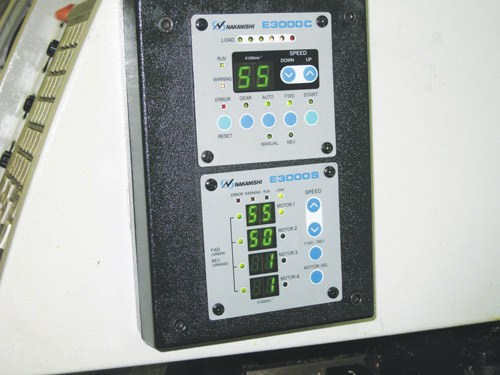Faster RPMs Produce Faster Turnaround
When running a metalworking shop, it’s common to have to adjust machining processes to accommodate customers’ demands.
When running a metalworking shop, it’s common to have to adjust machining processes to accommodate customers’ demands. Michigan Precision Swiss (St. Clair, Mich.) did just that when the company realized it needed a faster, more productive method of manufacturing small parts on its CNC Swiss machines. With the help of NSK spindles, the company was able to save 12 seconds per part, which resulted in hundreds of saved machining hours.
The company knew something must be done when new projects it was bidding on were taking too long to complete and bell mouthing and burrs were occurring. The solution was to increase the spindle RPM on the machines being used. “With small diameters like what we produce, it’s critical to eliminate burrs to create cleaner IDs,” says David Murphy, president.
Featured Content
Michigan Precision Swiss is a Swiss-type screw machining facility that specializes in fuel system components. The shop started out using air spindles in Tornos Deco 10A CNC Swiss-types to drill a 1-mm hole in brass. The air spindles were rated at 18,000 rpm, but when any aggressive type of feed was used, the spindles lost rpm, and the drills produced bell mouthed holes. Bell mouthing occurred because the drill was not drilling, but instead being pushed into the hole and deflecting at the mouth of the hole, making it larger than the bore.
The drill was also putting pressure on the 0.187-diameter part that caused the part to deflect or push away, also affecting accuracy. At that time, the shop’s only way to overcome this problem was to use a steady rest on the part and reduce the feed rate until the pressure causing the bell mouthing subsided.
Knowing there had to be a better, more efficient way to produce these parts, Dave Gordon and Scott Kriesch, the company’s CNC supervisors, reviewed information they received from PMTS 2009 about the NSK high speed electric EM20-S6000 spindle. NSK Regional Manager Ron Chambers ran a demo at the shop using the EM20 at 48,000 rpm, the customer’s drill and no steady rest to support the part.
The carbide drill initially used with the 18,000-rpm air spindle was replaced after three shifts because of premature wear and dulling. However, using the EM20 spindle, the company was able to get 40 days or more out of each drill because the machine was now drilling instead of wearing out the hole. The operators also were able to remove the steady rest because the part was no longer being pushed.
According to Mr. Chambers, conventional speeds on screw machines are inadequate to properly machine with small micro tooling. “When using a tool with a diameter of 2.0 mm or less, speeds of well over 10,000 rpm are required,” he explains. “Insufficient speed will greatly decrease tool life, extend machining cycle time and offer poor surface finishes as well as bell mouthing.”
Using high speed spindles allows the customer more freedom in the manufacturing process by using high speeds to cut and not rub the material, Mr. Chambers continues. “There is less pushing of the part, and the incredible spindle accuracy of 1 µm is unmatchable. High speeds allow the user to increase the machine feed rate, which equals dollars saved in manufacturing time at the spindle.”
Four Deco 10As were retrofitted as a result of the successful demo run. “Our technicians, primarily Scott Kriesch, know the ins and outs of the Decos, so we were able to retrofit in-house,” Mr. Murphy says. “Once you do one, it gets easier. The first machine was down for two shifts, as we converted the machines over, but the last one was down for only a matter of hours.”
The results of the spindle implementation allowed Michigan Precision Swiss to save 12 seconds per part or 1,600,000 seconds per job run. With this savings, the company is now processing new jobs using the faster machining techniques made possible by the new high speed spindles. Mr. Murphy says he foresees using the high speed spindles for other applications that require accurate, small holes.
RELATED CONTENT
-
Making Waves with Lathe Automation
After years of relying on an extensive machining cell for part production, this marine equipment manufacturer has now reduced part handling and improved quality through use of single-setup lathes and automated loading and unloading.
-
Turning to an Adhesive for Lathe Workholding
Adhesive cured by ultraviolet light is an option for securing parts for machining that could otherwise distort when traditional, mechanical clamping techniques are used.
-
Advancements in Thread Whirling Tooling Technology
Many understand the advantages of thread whirling on a CNC Swiss-type. However, new tooling technology for this thread-machining process can further improve cycle times and reduce cost per part.








